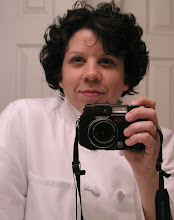



Last week we had a banquet for 650 people, a birthday party. I knew when the banquet was mentioned at our morning line-up that the task would be an all hands on board project. (While L'auberge regularly does banquets this large it was my first since we see more large banquets during the holiday season.) The original plan was to make cupcakes. Somewhere along the way the plate-up changed to a individual size yellow bundt cake with, strawberry sauce and chantilly cream; a deconstructed strawberry shortcake.
To accomplish the task we laid out a table with sheet pans and placed the plates on each pan, then built layers of sheet pans and plates. We needed a total of 109 sheet pans to hold all those plates! Ok, I admit it, I had not imagined doing a plate-up of this magnitude when I started in this field and it is amazing to watch all the tricks the people who came before me have devised! Fascinating.
The plate-up took a staff of five about two hours. A lot of that time was spend gathering racks, sheet pans and getting 650 dessert plates that matched. The cakes had been baked off during the week and the strawberry sauce was made the day before. The chantilly cream was whipped as we went (there was some problem with it being too soft.) The actual task of putting the plate together was a well corriographed "dance." The bundt cakes were placed at the 2 o'clock position on the plate, another person followed behind piping a chantilly rosette in the 8 o'clock position, followed by another placing the chocolate sticks at an angle on the rosette, yet another person placed the "Happy Birthday" chocolate sail on the plate while another staff member placed strawberry sauce on the cake, the final touch was a sprinkle of powdered sugar across the cake. The plate's rims were wiped and they were removed to a rack, revealing a new set of plates for our dance to begin again. It was a like a team relay and found that it built a level of trust and comradery I had yet to see with this staff.
*Sorry about the photo quality. The pictures were taken in a rush on my iPhone, we had bigger priorities to worry about, but I couldn't resist sharing this with all of you.




2 comments:
Wow. That's a lot of cake...
Hey, you need to start an "Ask Sweetie Pie's Bake Shop" page on here. I get the first question - what's up with all the different kinds of butter? Why does it matter? When do you want salted vs. nonsalted vs. demi-sal?
You need to do that - if you ever stop plating those cakes.
Okay, I'm working on it. I found one that will work but let me know if you see a gadget that will work particularly well for that purpose.
In the mean time, the first answer: you always want to use unsalted in baking formulas. (Unless the recipe specifically calls for salted, which it rarely would.) I've never seen salted butter in a professional kitchen. Use unsalted butter and add the seasonings yourself.
The question I never knew to ask is this: what is the water content in my butter? Well, of course there is water in your butter but, I didn't know that is what makes European butter, New Zealand butter, US butter all so different. The amount of water in your butter can make a difference in your product. As you have probably noticed in France that European butter is much richer than our butter. I'm still studying this as I have never seen a butter label admitting a water % on the package. Honestly, the idea that butter could be that different and that it could effect my product as much as which flour (gluten %) I use is all new to me. And quite fascinating.
Post a Comment